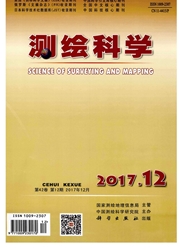

 中文摘要:
中文摘要:
在利用遥感影像更新GIS矢量数据的过程中,往往忽略了对已知信息的有效利用,针对这一问题,本文提出一种基于点分布的双蛇模型用于GIS矢量数据更新,该模型利用已有遥感影像信息计算目标边界点的平均分布,以此为“镜面”建立初始矢量边界的“镜像”,将两边界各自演化的结果取平均作为更新后的GIS矢量边界。该方法同时利用了GIS和遥感的历史数据作为先验知识,分别作为蛇模型的初始位置和区域约束信息,使遥感与GIS信息结合更加紧密。仿真实验表明,基于点分布的双蛇模型在GIS矢量边界更新的应用中,可以得到比以传统蛇模型更好的更新准确率和多边形相似度,并且接近手工方法的效果。
 英文摘要:
英文摘要:
Owing to the insufficient utilization of the prior knowledge during remote sensing images-based vector edge update in GIS, an improvement about dual snake model combined with points distribution is proposed in this paper. The mean edge points distribution is calculated using existing remote sensing images, depending on which, a mirror is generated to construct the symmetric vector edge to initial vector edge deriving from GIS data. Consequently, the mean vector edge between the dual vector edges lying in the double sides of the mirror is treated as the result. The innovation consists of the fact that the model presented here takes full advantage of prior knowledge available from remote sensing images and GIS data, which implements the compact incorporation between information of RS and GIS. Experiments are performed on vector edges and TM remote sensing image of Zhalong Wetland in China to validate the advantages of dual snake model with point distribution in vector edge update over the original snake. The result is approaching to manual approach.
 同期刊论文项目
同期刊论文项目
 同项目期刊论文
同项目期刊论文
 The hidden neurons selection of the wavelet networks using support vector machines and ridge regress
The hidden neurons selection of the wavelet networks using support vector machines and ridge regress 期刊信息
期刊信息
